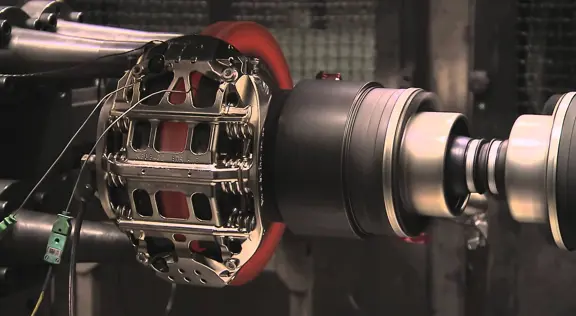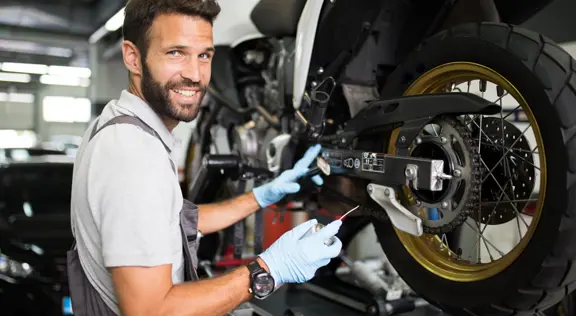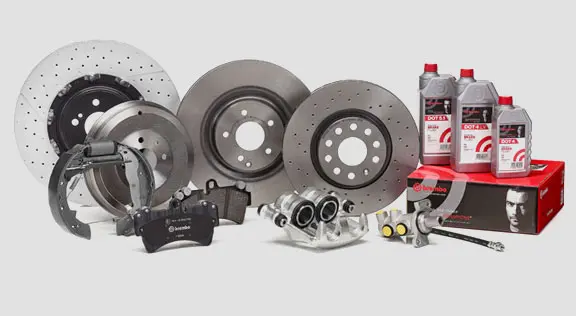
The brakes of the future: Braking system and spare parts
Part 3. Designing the brakes of the future and effects on the market
We are concluding this journey into the future of braking systems with a few insights into the effects that current trends will have in the design of the brakes of the future and on the effects on the spare parts market, where Brembo plays a key role thanks to its commitment to technological development, research and continued development.
In recent years, the weight of hybrid and electric vehicles has increased considerably, as you can see in fig. 3. This illustrates three equivalent models in terms of performance levels but with different types of powertrain of the Golf VII. The petrol model is the lightest but has high CO2 emissions, while the hybrid model and the all-electric model weigh nearly 300 kg more than their petrol counterpart. This weight increase is mainly attributed to the considerable weight of the batteries, which also increases the thermal stress on the braking system.
So, how should the brakes of tomorrow be designed? And what criteria should they meet?
Below is an analysis of the requirements of the cars of the future in terms of braking systems, and in particular regenerative braking which electric cars use significantly in addition to traditional friction braking.
Regenerative braking in hybrid and electric cars
The regenerative brake means that the vehicle requires much lesser use of the traditional friction brake in hybrid and electric cars. In theory, therefore, braking systems can be downsized and made with smaller brake discs. Having said that, it is vital that the brakes deliver their maximum performance even without regenerative braking, because in certain conditions regenerative braking is unable to work, so safety must be factored in.
Moreover, the noise generated by the braking system has to be eradicated, in keeping with the reduced noise of electric cars.
Binding, corrosion, friction and design
Eliminating binding is another necessity, since binding in electric vehicles can compromise the energy balance of the system and hence the range.
Additionally, the fact that electric vehicles make less frequent use of friction brakes can lead to undue corrosion of the brake discs and pads, bearing in mind that the friction coefficient must be stable, even if the braking system has been left unused for long periods.
Overall, we can sum up by stating that brakes for electric vehicles require dedicated development, and this opens up considerable potential for innovation in the fields of corrosion prevention, friction materials and lightweight design.
Effects on the market
In recent years, the majority of car manufacturers on the market have expanded the range of models and types of powertrain available to consumers.
The global market is still essentially based 98% on cars with an internal combustion engine, whereas electric or hybrid cars today still account for a negligible percentage. Although we are unaware how this percentage will grow, we do know that it will be significant, and this will lead to an even broader variety and greater diversification of models compared to those currently available.
Conclusions
In conclusion, the factors which will affect the future car market will mainly be:
- environmental sustainability which will lead to new regulations, with the emerging markets providing a significant contribution in this field
- new technologies, electrification, the strategic choices of manufacturers and the presence on the market of new players
- the new generation of users, system connectivity and the new levels achieved by autonomous driving technology.
These changes may occur very quickly, similarly to the world of communications, which saw us switch in a very short space of time from landlines to smartphones, from paper to computers, from newspapers to the Internet, from communicating among people to socialising on social media. All in just under 15 years.
The changes are quick when a series of new technologies result in new products, which is why companies and professionals need to be ready not only to recognise change and embrace it, but also to use their know-how to shape it, and grasp the new market opportunities.
Most importantly, the most important factor is the knowledge and ability to develop the new technologies that the market needs, as well as the ability to access data and information, the ability to offer new products and services, the willingness to embrace digital transformation and professionalisation, and above all the desire and ability to study and keep up to date in a constantly changing world.
Is there anything else you want to ask?
Contact the Brembo technical support team. Our technicians will get back to you as soon as possible!







